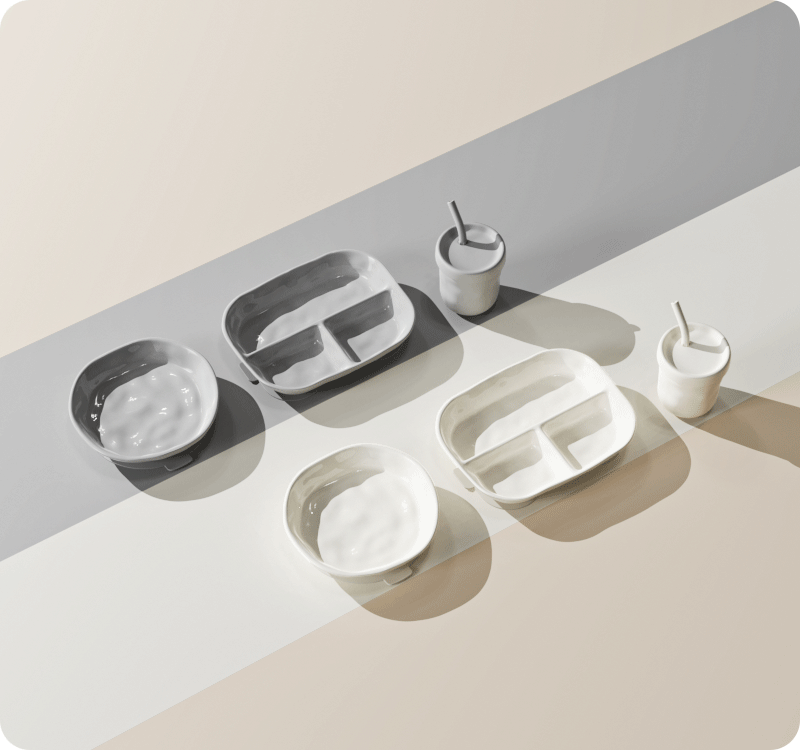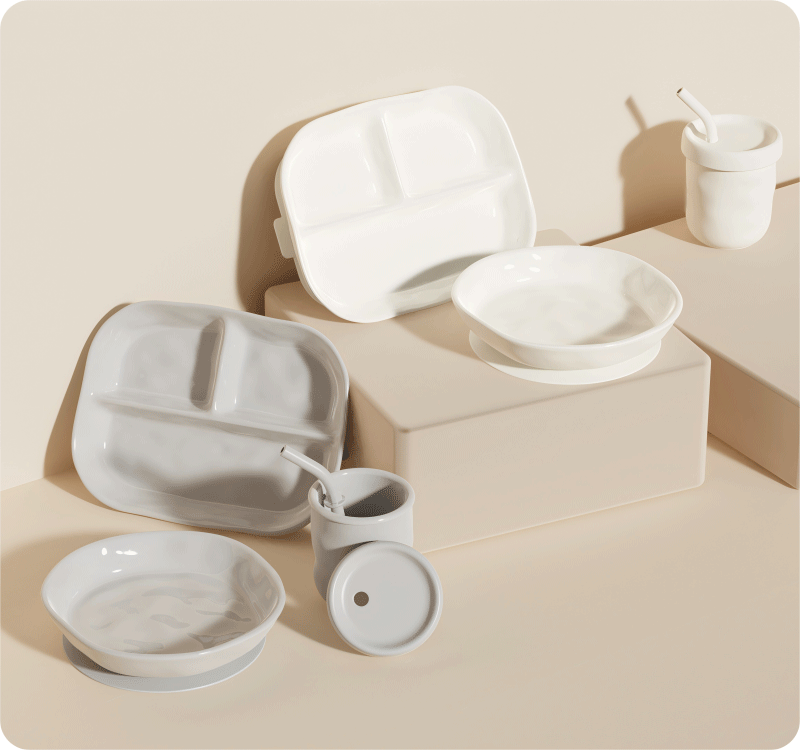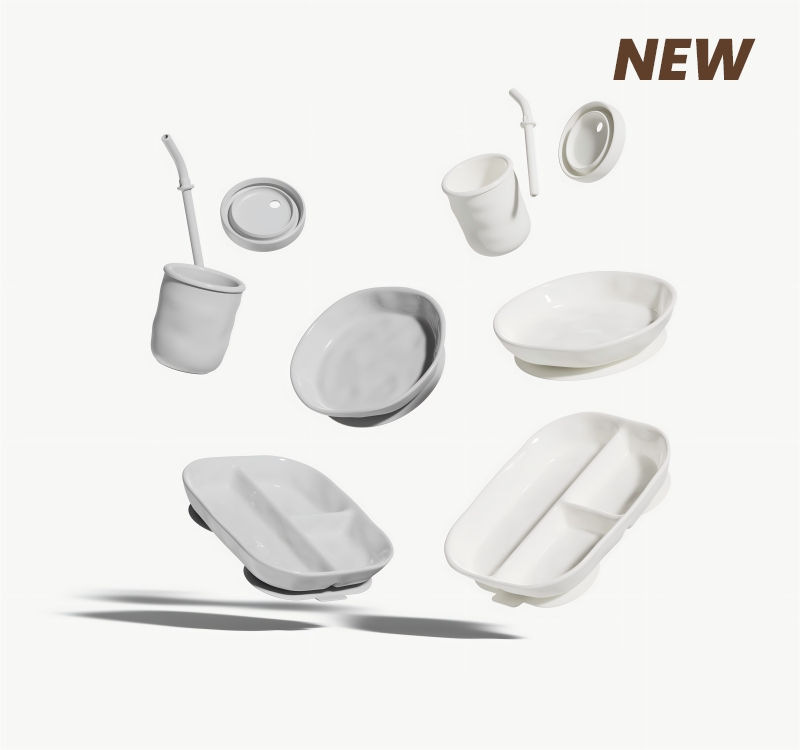When it comes to choosing the right dinnerware for your family, particularly for young children, the debate often revolves around safety, durability, and sustainability. In recent years, silicone plates have emerged as a popular alternative to plastic ones. They are often touted for their safety, durability, and eco-friendliness. But are silicone plates really better than plastic ones? In this comprehensive blog, we will explore both materials, examining their pros and cons to help you make an informed decision. We will also take a close look at specific types of silicone dinnerware, including silicone divided plates, which have gained popularity for their practicality.
Understanding Silicone and Plastic: What are They Made of?
Silicone is a synthetic polymer made from silica (sand) and oxygen. It's a highly flexible material that can withstand extreme temperatures and is resistant to chemicals and bacteria. Unlike plastic, silicone doesn't degrade into microplastics, making it a more environmentally friendly option in terms of material composition.
Plastic, on the other hand, is typically made from petrochemicals. Most plastic plates are crafted from either polypropylene (PP) or polycarbonate (PC). These types of plastics can be durable and affordable, but they have been scrutinized for their potential health risks, especially when exposed to heat.
Silicone Plates vs. Plastic Plates: A Comparative Overview
Let's break down the key factors that are often considered when choosing between silicone plates and plastic ones:
a) Safety and Health Considerations
Silicone Plates: Silicone dinnerware is considered safe because it is free from harmful chemicals like BPA, phthalates, and PVC. It is non-toxic and food-grade silicone is used in many baby products because it doesn’t react with food, even at high temperatures.
Plastic Plates: Many plastic plates are made with chemicals that could pose health risks, particularly when heated. Although BPA-free plastics have become more common, there are still concerns about other chemicals that could leach into food over time.

b) Durability
Silicone Plates: Silicone plates are highly durable and resistant to breakage. They are flexible, which means they are unlikely to crack or shatter even when dropped. Silicone divided plates, in particular, are designed to withstand daily use by toddlers who may throw or drop them frequently.
Plastic Plates: Plastic plates can also be durable, but they are more likely to crack, warp, or wear down over time, especially when exposed to high heat, such as in a microwave or dishwasher.
c) Heat Resistance
Silicone Plates: One of the major advantages of silicone plates is their ability to withstand high temperatures. They can be safely used in the oven, microwave, and dishwasher without any degradation. This makes silicone dinnerware highly versatile.
Plastic Plates: While some types of plastic plates can be used in the microwave, many cannot withstand high heat without warping or releasing chemicals. Plastic plates may melt or become discolored when exposed to high temperatures, limiting their versatility.
d) Environmental Impact
Silicone Plates: Silicone is considered more eco-friendly than plastic because it lasts longer and doesn't break down into harmful microplastics. However, silicone is not biodegradable. Still, because it is more durable and has a longer lifespan, it is a better option in terms of reducing waste.
Plastic Plates: Plastic plates contribute significantly to environmental waste. Many plastic products are single-use and end up in landfills or oceans. Even recyclable plastics are not always processed, leading to long-term environmental damage.
e) Ease of Cleaning
Silicone Plates: Silicone dinnerware is incredibly easy to clean. It is non-porous, meaning it doesn't absorb food stains or odors, and can be easily washed in a dishwasher. This makes silicone divided plates especially useful for parents of young children, as each compartment can be cleaned thoroughly and without hassle.
Plastic Plates: Plastic plates can stain, especially if used with tomato-based foods or other sauces. Over time, plastic can also absorb odors, making them less appealing for long-term use. Additionally, some plastic plates can warp in the dishwasher.
![]()
Are Silicone Plates Safe for Babies and Toddlers?
For parents, the safety of dinnerware is a top priority. Silicone plates, especially silicone divided plates, are increasingly being marketed as a safe option for babies and toddlers. But are they really the best choice?
Safety Factors for Silicone Dinnerware:
- Non-Toxic: Silicone is free from harmful chemicals found in some plastics, like BPA and phthalates, making it a safer option for young children.
- Durability: Silicone plates are flexible and nearly unbreakable, which is crucial when dealing with toddlers who tend to throw things.
- Heat Resistance: Silicone plates can be safely used in the microwave to warm up food without releasing any harmful chemicals, unlike certain plastics that can break down.
Other Considerations:
- Suction Base: Many silicone plates come with suction bases, which help prevent the plate from being knocked over during mealtimes. This feature is particularly useful when training toddlers to eat independently.
- Portion Control: Silicone divided plates can also assist with portion control, allowing parents to offer a variety of foods without mixing them together. This can be helpful for picky eaters.
- Given these factors, silicone dinnerware is often considered one of the safest options for babies and toddlers.
Silicone Divided Plates: A Convenient Choice for Families
One of the most popular types of silicone dinnerware is the silicone divided plate. These plates are designed with separate compartments, which can be particularly beneficial for children. Here's why:
a) Portion Control and Variety
The divided sections allow parents to portion out food in a balanced way, ensuring that children are exposed to a variety of food groups. It's easier to offer fruits, vegetables, proteins, and grains without them mixing together, which can be especially appealing for picky eaters.
b) Less Mess
The raised dividers help to contain the food, preventing it from spilling over onto the table or floor. This can significantly reduce mess during mealtimes, particularly when toddlers are learning to feed themselves.
c) Suction Cup Design
Many silicone divided plates come with a suction base that can stick to high chairs or tables, preventing the plate from being easily knocked over. This feature is a game-changer for parents dealing with toddlers who tend to throw their plates.
d) Easy to Store and Travel-Friendly
Silicone divided plates are flexible and lightweight, making them easy to store or pack for travel. Unlike plastic plates that can take up more space and become warped over time, silicone plates maintain their shape and can even be folded or rolled for easy storage.
![]()
How Do Silicone Plates Impact the Environment?
Another factor to consider when deciding between silicone plates and plastic ones is the environmental impact of each.
a) Silicone's Environmental Footprint
Although silicone is not biodegradable, it is more environmentally friendly than plastic for several reasons. Silicone lasts longer, which means fewer plates are thrown away over time. Additionally, silicone can be recycled in specialized facilities, although this is less common than traditional plastic recycling.
b) The Problem with Plastic Waste
Plastic plates, especially those that are not recyclable, contribute significantly to environmental waste. Even "recyclable" plastic often ends up in landfills due to contamination or limited recycling infrastructure. As a result, plastic waste is a major contributor to pollution and the degradation of marine ecosystems.
Cost Considerations: Are Silicone Plates Worth the Price?
When comparing silicone plates to plastic ones, the price is often a key consideration. Silicone plates are typically more expensive upfront than plastic plates. However, the long-term benefits may outweigh the initial cost.
a) Longevity of Silicone Plates
Because silicone is so durable, it is likely to last much longer than plastic plates. You won't need to replace silicone plates as often, which can save money in the long run.
b) Lower Replacement Costs
Plastic plates may be cheaper upfront, but they tend to wear out more quickly. They can crack, warp, or become stained, leading to more frequent replacements. Over time, this can make plastic plates more expensive than investing in silicone plates from the start.
c) Investment in Safety
For parents, the safety of their children is often worth the higher cost. Silicone plates are free from harmful chemicals and are highly durable, making them a sound investment in terms of health and longevity.
Can Silicone Plates Replace Plastic in the Long Run?
In the ongoing debate of silicone versus plastic, silicone plates appear to come out on top in many key areas. They are safer, more durable, environmentally friendly, and versatile. As families become more conscious of the materials they use, particularly for children, silicone dinnerware may well replace plastic as the go-to option for everyday use.
Challenges to Consider:
- Availability and Cost: While silicone plates are becoming more widely available, they are still pricier than plastic ones. For families on a budget, this may be a deciding factor.
- Recycling: Silicone, while recyclable in some areas, does not have the widespread recycling infrastructure that plastic does. This means that when silicone plates do reach the end of their life, disposing of them sustainably may be more challenging.
Final Verdict: Are Silicone Plates Better Than Plastic Ones?
In terms of safety, durability, and environmental impact, silicone plates come out as a superior option compared to plastic plates. Especially for families with young children, silicone dinnerware provides a safer, more sustainable alternative that can withstand daily use and the occasional toss across the room.
Key Advantages of Silicone Plates:
- Non-toxic and free from harmful chemicals.
- Highly durable and resistant to breakage.
- Heat resistant and microwave-safe.
- Environmentally friendlier, with a longer lifespan.
- Easy to clean and maintain, particularly silicone divided plates.
While plastic plates may still have a place in some households due to their lower cost, their potential health risks, environmental damage, and shorter lifespan make them a less attractive option in the long run.

Conclusion
In the debate between silicone plates and plastic ones, silicone dinnerware clearly offers numerous advantages. From its safety and non-toxic composition to its durability and eco-friendliness, silicone plates are a superior option for families looking to prioritize health, sustainability, and long-term cost savings. They withstand high heat, resist stains, and are easy to clean, making them particularly practical for parents with young children. Silicone divided plates, in particular, help keep meals organized and mess-free, while the suction base prevents spills during mealtimes.
While plastic plates may be cheaper upfront, their short lifespan, potential health risks, and negative environmental impact make them less appealing for long-term use. As families become more conscious of the materials they bring into their homes, silicone plates are emerging as the smarter, safer, and more sustainable choice. Whether you're looking to reduce your environmental footprint or ensure the safety of your loved ones, investing in silicone dinnerware is a decision that offers lasting benefits.
With their superior performance in safety, durability, and convenience, it’s clear that silicone plates are indeed better than plastic ones, and they represent a valuable investment in both your family’s health and the planet’s future.


